Transforming wastewater treatment through innovation, sustainability and community value
The Sterling Natural Resource Center (SNRC) in San Bernardino, California, sets a new benchmark in sustainable water infrastructure. Delivered by Balfour Beatty with lead designer Arcadis and architect Ruhnau Clark Architects, this £165 million progressive design-build project provides a long-term solution for wastewater treatment, energy generation and community education. Construction for SNRC began in October 2018, and the site was fully operational in May 2024.

Construction on the 20-acre site began in October 2018, with it becoming fully operational in May 2024, and capable of treating 8 million gallons of wastewater per day (mgd) – up to 10mgd at peak processing. The facility not only enables the region to self-manage its water resources but also provides a resilient, drought-proof water supply by recharging the local groundwater aquifer—an essential step in securing water sustainability in one of the driest areas of the United States.
Designed with climate and community in mind
At the heart of the project is a co-digestion system that combines wastewater sludge and locally sourced food waste to produce up to 3 megawatts of renewable electricity—enough to power nearly 2,000 homes. This enhancement allows SNRC to produce enough renewable electricity to meet the facility’s energy needs, further supporting SNRC’s net zero energy ambition by offsetting operational carbon emissions and reducing landfill waste. All electricity generated beyond the facility’s needs is fed back into the local energy grid.
Gallons of water treated per day
Of renewable energy generated on-site
Worked with only one-lost time incident over five years
The SNRC also includes a 14,000 sq ft administrative centre and landscaped community spaces, including a demonstration garden, picnic areas, and educational walkways. The site was designed not only for operational excellence but also to enhance biodiversity and promote community learning, with regular tours and school engagement embedded in the programme.
Delivering safely through partnership
Delivered on time, on budget and with only one lost-time incident in 800,745 total hours worked – an outstanding safety record, SNRC exemplifies the benefits of a collaborative design-build approach. The project team prioritised early contractor involvement, flexible design development and strong stakeholder engagement to deliver a technically complex scheme with long-lasting impact.
Supporting social value
Community benefits were a key priority, with 81% of the workforce hired locally, and 94 local businesses—including 29 Disabled Veteran Business Enterprises—were engaged. The project also introduced many of its team to progressive design-build delivery for the first time, creating a pipeline of skilled workers for future infrastructure projects.
The Sterling Natural Resource Center goes beyond conventional water treatment to become a catalyst for environmental, economic and social resilience—proving that critical infrastructure can be sustainable, inclusive and community-focused.